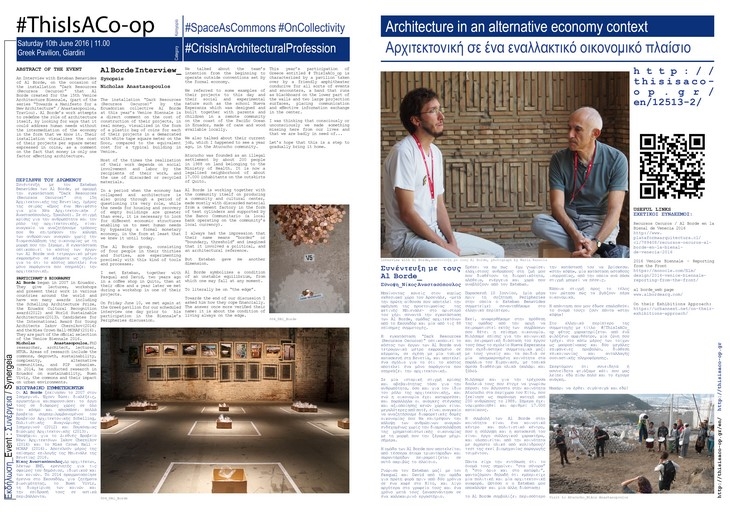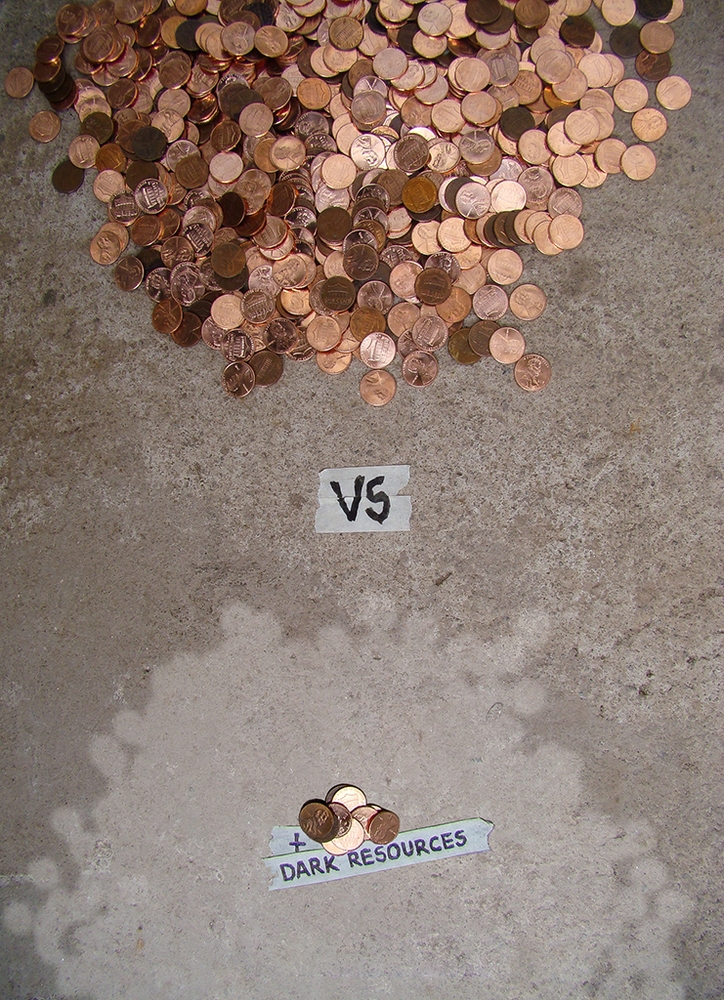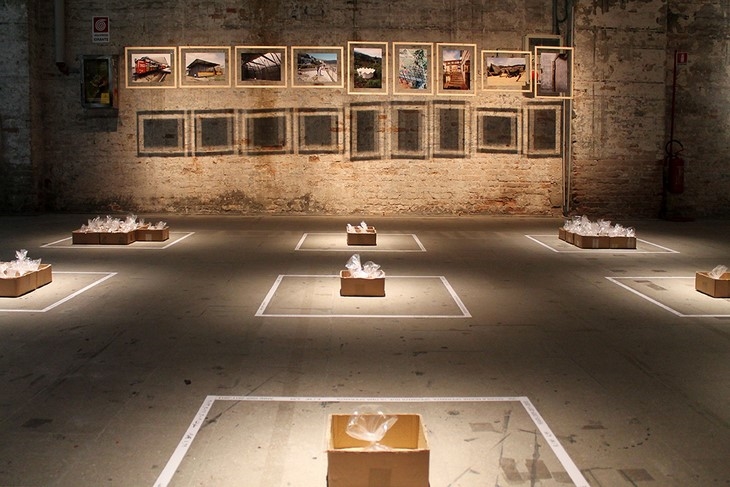EN / GR
ABSTRACT OF THE EVENT
An Interview with Esteban Benavides of Al Borde, on the occasion of the installation “Dark Resources (Recursos Oscuros)” that Al Borde created for the 15th Venice Architecture Biennale, (part of the series “Towards a Manifesto for a New Architecture” / Anastasopoulos, Travlou). Al Borde’s work attempts to redefine the role of architecture itself, by looking for ways that it could address human needs without the intermediation of the economy in the form that we know it. Their installation visualizes the cost of their projects per square meter expressed in coins, as a comment on the fact that money is only one factor of architecture.
PARTICIPANT’S BIOGRAPHY
Al Borde began in 2007 in Ecuador. They give lectures, workshops and present their work in various countries around the world and have won many awards including the Schelling Architecture Prize, the Ecuador Cultural Recognition award (2012) and World Sustainable Architecture (2013). Candidates for the International Award for Young Architects Iakov Chernikov (2014) and the Mies Crown Hall-MCHAP (2016). They are part of the official selection of the Venice Biennale 2016.
Nicholas Anastasopoulos, PhD researcher, architect, lecturer, NTUA. Areas of research include the commons, degrowth, sustainability, complexity, alternative communities, and P2P urbanism. In 2014, he conducted research in Ecuador on sustainability, Buen Vivir, the commons and their impact on urban environments.
Al Borde Interview (Synopsis: Nicholas Anastasopoulos)
The installation “Dark Resources (Recursos Oscuros)” by the Ecuadorian collective Al Borde at this year’s Venice Biennale is a direct comment on the cost of construction of their projects in a demarcated with white tape square meter on the floor compared to the equivalent cost for a typical building in Venice. Most of the times the realization of their work depends on social involvement and labor by the recipients of their work, and the use of discarded or recycled materials.
In a period when the economy has collapsed and architecture is also going through a period of questioning its very role, while the needs for housing and recovery of empty buildings are greater than ever, it is necessary to look for different economic structures enabling us to meet human needs by bypassing a formal monetary economy, in the form at least that we knew it until today. The Al Borde group, consisting of four people in their thirties and forties, are experimenting precisely with this kind of tools and processes. I met Esteban, together with Pasqual and David, two years ago in a coffee shop in Quito, then at their office and a year later we met during a workshop in one of their projects.
On Friday June 10, we met again at the Greek pavilion for our scheduled interview one day prior to his participation in the Biennale’s Peripheries discussion. We talked about the team’s intention from the beginning to operate outside conventions set by the formal economy.
We referred to some examples of their projects to this day and their social and experimental nature such as the school Nueva Esperanza which was designed and built together with parents and children in a remote community on the coast of the Pacific Ocean in Ecuador, made of cane and wood available locally. We also talked about their current job, which I happened to see a year ago, in the Atucucho community.
Atucucho was founded as an illegal settlement by about 200 people in 1988 on land belonging to the Ministry of Health. It is now a legalized neighborhood of about 17.000 inhabitants on the outskirts of Quito. Al Borde is working together with the community itself on producing a community and cultural center, made mostly with discarded material from a cement factory in the form of test cylinders and supported by the Banco Communitario (a local bank operating on the community’s local currency).
I always had the impression that their name means “border” or “boundary, threshold” and imagined that it involved a political, and an architectural reference. But Esteban gave me another dimension. Al Borde symbolizes a condition of an unstable equilibrium, from which one may fall at any moment. To literally be on “the edge”. Towards the end of our discussion I asked him how they cope. The answer once more verified their name: it is about the condition of living always on the edge.
This year’s participation of Greece entitled # ThisIsACo_op is characterized by a pavilion taken over by a friendly amphitheater conducive for all sorts of events and encounters, a band that runs as blackboard on the lower part of the walls and two large projection surfaces, placing communication and effective information exchange in the center.
I was thinking that consciously or unconsciously we made something missing here from our lives and that we are badly in need of…Let’s hope that this is a step to gradually bring it home.
ΠΕΡΙΛΗΨΗ ΤΟΥ ΔΡΩΜΕΝΟΥ
Συνέντευξη με τον Esteban Benavides των Al Borde, με αφορμή την εγκατάσταση “Dark Resources (Recursos Oscuros)” στη 15η Αρχιτεκτονικής της Βενετίας, (μέρος της σειράς «Προς ένα Μανιφέστο για μία Νέα Αρχιτεκτονική» / Αναστασόπουλος, Τραυλού). Σε στιγμή κρίσης για την ανθρωπότητα και τον ρόλο της αρχιτεκτονικής, είναι αναγκαίο να αναζητήσουμε τρόπους που θα επιτρέψουν την κάλυψη των ανθρώπινων αναγκών χωρίς την διαμεσολάβηση της οικονομίας με τη μορφή που την ξέραμε. Η εγκατάσταση οπτικοποιεί το κόστος των έργων των Al Borde ανά τετραγωνικό μέτρο εκφρασμένο σε κέρματα ως σχόλιο για το ότι το κόστος αποτελεί ένα μόνο παράγοντα που επηρεάζει την αρχιτεκτονική.
ΒΙΟΓΡΑΦΙΚΟ ΣΥΜΜΕΤΕΧΟΝΤΩΝ
Οι Al Borde ξεκίνησαν το 2007 στον Ισημερινό. Έχουν δώσει διαλέξεις, εργαστήρια και παρουσιάσει το έργο τους σε διάφορες χώρες σε όλο τον κόσμο και αποσπάσει πολλά βραβεία συμπεριλαμβανομένου του Βραβείου Αρχιτεκτονικής Schelling, Πολιτιστικής Αναγνώρισης του Ισημερινού (2012) και Παγκόσμιας Βιώσιμης Αρχιτεκτονικής (2013).
Υποψήφιοι για το Διεθνές Βραβείο Νέων Αρχιτεκτόνων Iakov Chernikov (2014) και το Mies Crown Hall – MCHAP (2016). Αποτελούν μέρος της επίσημης επιλογής της Μπιενάλε της Βενετίας 2016.
Νίκος Αναστασόπουλος, Δρ αρχιτέκτων, λέκτωρ ΕΜΠ, ερευνητής για τις σφαίρες του δημόσιου, ιδιωτικού και των κοινών. Το 2014 πραγματοποίησε έρευνα στο Εκουαδόρ, για ζητήματα βιωσιμότητας, το Buen Vivir, τη διαχείριση των κοινών και την επίδρασή τους σε αστικά περιβάλλοντα.
Συνέντευξη με τους Al Borde (Σύνοψη: Νίκος Αναστασόπουλος)
Μπαίνοντας κανείς στον κυρίως εκθεσιακό χώρο του Αρσενάλε, -μετά την πρώτη αίθουσα που αποτελεί την αφήγηση της προετοιμασίας της φετινής Μπιενάλε- στο αριστερό του χέρι συναντά την εγκατάσταση των Al Borde, ομάδας αρχιτεκτόνων από το Εκουαδόρ και μία από τις 88 επίσημες συμμετοχές.
Η εγκατάσταση “Dark Resources (Recursos Oscuros)” οπτικοποιεί το κόστος των έργων των Al Borde ανά τετραγωνικό μέτρο εκφρασμένο σε κέρματα, σε σχέση με μία τυπική κατασκευή στη Βενετία, και αποτελεί ένα σχόλιο για το ότι το κόστος αποτελεί ένα μόνο παράγοντα που επηρεάζει την αρχιτεκτονική.
Σε μία ιστορική στιγμή κρίσης και αβεβαιότητας τόσο για την ανθρωπότητα, όσο και για τον ίδιο τον ρόλο της αρχιτεκτονικής, και ενώ η οικονομία έχει καταρρεύσει και παράλληλα οι ανάγκες στέγασης και αξιοποίησης κενών χώρων είναι μεγαλύτερες από ποτέ, είναι αναγκαίο να αναζητήσουμε διαφορετικές δομές οικονομίας που θα επιτρέψουν την κάλυψη των ανθρώπινων αναγκών ενδεχομένως χωρίς την διαμεσολάβηση της χρηματοπιστωτικής οικονομίας με τη μορφή που την ξέραμε μέχρι σήμερα.
Η ομάδα των Al Borde που αποτελείται από τέσσερα άτομα τριαντάρηδων και σαραντάρηδων πειραματίζεται σε αυτό ακριβώς το πλαίσιο. Γνώρισα τον Esteban μαζί με τον Pasqual και David από την ομάδα για πρώτη φορά πριν από δύο χρόνια σε ένα καφέ στο Κίτο, και λίγο αργότερα στο γραφείο τους και ένα χρόνο μετά τους ξανασυνάντησα σε ένα καλοκαιρινό εργαστήριο.
Πρέπει να πω πως έχω γνωρίσει ελάχιστους ανθρώπους στη ζωή μου που διαθέτουν τη διορατικότητα, αλήθεια, ενέργεια και χαρά που αναβλύζουν από τον Esteban. Παρασκευή 10 Ιουνίου, (μία μέρα πριν τη συζήτηση Peripheries στην οποία ο Esteban Benavides συμμετείχε) συναντηθήκαμε στο ελληνικό περίπτερο.
Εκεί, αναφερθήκαμε στην πρόθεση της ομάδας από την αρχή να πειραματιστεί εκτός των συμβάσεων που θέτει η επίσημη οικονομία. Μιλήσαμε επίσης για την κοινωνική και πειραματική διάσταση του έργου τους όπως το σχολείο Nueva Esperanza που σχεδιάστηκε συμμετοχικά μαζί με τους γονείς και τα παιδιά σε μία απομακρυσμένη κοινότητα στα παράλια του Ειρηνικού, με τοπικά άμεσα διαθέσιμα υλικά (καλάμι και ξύλο).
Μιλήσαμε και για την τρέχουσα δουλειά τους που έτυχε να γνωρίσω πέρυσι τον Αύγουστο στην κοινότητα Atucucho στα περίχωρα του Κίτο, που ξεκίνησε ως παράνομη κατοχή από 200 ανθρώπους το 1988. Σήμερα έχει νομιμοποιηθεί και αριθμεί 17.000 κατοίκους.
Η συμβολή των Al Borde στην κοινότητα είναι ένα κοινοτικό κέντρο και πολιτιστικό κέντρο, που η σύλληψη και η κατασκευή του είναι έργο συλλογικού χαρακτήρα, και υλοποιείται από την κοινότητα με άχρηστο υλικό από κυλίνδρους/ τεστ της εκεί βιομηχανίας παραγωγής τσιμέντου.
Πάντα είχα την εντύπωση ότι το όνομά τους σημαίνει “στα σύνορα” ή “στο όριο και στο κατώφλι”, φανταζόμουν δηλαδή ότι εμπεριείχε μία πολιτική και μία αρχιτεκτονική αναφορά. Ωστόσο ο ο Esteban μου αποκάλυψε και μία άλλη διάσταση:
το Al Borde συμβολίζει περισσότερο την κατάστασή του να βρίσκεσαι «στην κόψη», μία κατάσταση ασταθούς ισορροπίας, από την οποία ανά πάσα στιγμή μπορεί να πέσεις. Κάποια στιγμή προς το τέλος τον ρώτησα πώς τα βγάζουν πέρα οικονομικά.
Η απάντηση που μου έδωσε επαληθεύει το όνομά τους: ζουν πάντα «στην κόψη»!
Στο ελληνικό περίπτερο της συμμετοχής με τίτλο #ThisIsACo_ op φέτος χαρακτηρίζεται από ένα φιλόξενο αμφιθέατρο, μία ζώνη που τρέχει στο κάτω μέρος των τοίχων ως μαυροπίνακας και δύο μεγάλες επιφάνειες προβολών, διάθεση επικοινωνίας και ανταλλαγής ουσιαστικής πληροφόρησης.
Σκεφτόμουν ότι συνειδητά ή ασυνείδητα φτιάξαμε κάτι που μας λείπει εδώ πίσω πολύ και το έχουμε ανάγκη…Μακάρι να έρθει σιγά-σιγά και εδώ!
USEFUL LINKS / ΣΧΕΤΙΚΟΙ ΣΥΝΔΕΣΜΟΙ:
 ARCHITECTURE IN AN ALTERNATIVE ECONOMY CONTEXT: AN INTERVIEW WITH AL BORDE ARQUITECTOS (SYNELEUSIS)
ARCHITECTURE IN AN ALTERNATIVE ECONOMY CONTEXT: AN INTERVIEW WITH AL BORDE ARQUITECTOS (SYNELEUSIS) ARCHITECTURE IN AN ALTERNATIVE ECONOMY CONTEXT: AN INTERVIEW WITH AL BORDE ARQUITECTOS (SYNELEUSIS)
ARCHITECTURE IN AN ALTERNATIVE ECONOMY CONTEXT: AN INTERVIEW WITH AL BORDE ARQUITECTOS (SYNELEUSIS) ARCHITECTURE IN AN ALTERNATIVE ECONOMY CONTEXT: AN INTERVIEW WITH AL BORDE ARQUITECTOS (SYNELEUSIS)
ARCHITECTURE IN AN ALTERNATIVE ECONOMY CONTEXT: AN INTERVIEW WITH AL BORDE ARQUITECTOS (SYNELEUSIS)READ ALSO: ΔΙΑΓΩΝΙΣΜΟΣ ΙΔΕΩΝ ΓΙΑ ΤΗΝ ΜΕΛΕΤΗ ΑΝΑΠΛΑΣΗΣ 640 ΣΤΡΕΜΜΑΤΩΝ ΤΗΣ ΠΡΩΗΝ ΛΙΜΕΝΟ-ΒΙΟΜΗΧΑΝΙΚΗΣ ΠΕΡΙΟΧΗΣ ΛΙΠΑΣΜΑΤΩΝ